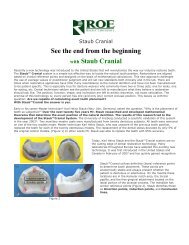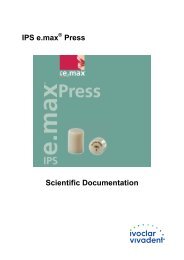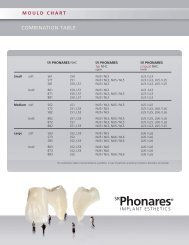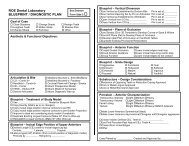IPS e.max Ceram Scientific Documentation - ROE Dental Laboratory
IPS e.max Ceram Scientific Documentation - ROE Dental Laboratory
IPS e.max Ceram Scientific Documentation - ROE Dental Laboratory
You also want an ePaper? Increase the reach of your titles
YUMPU automatically turns print PDFs into web optimized ePapers that Google loves.
<strong>Scientific</strong> <strong>Documentation</strong> <strong>IPS</strong> e.<strong>max</strong> ® <strong>Ceram</strong> Page 4 of 21<br />
1.2 <strong>IPS</strong> e.<strong>max</strong> <strong>Ceram</strong><br />
<strong>IPS</strong> e.<strong>max</strong> <strong>Ceram</strong> is a veneering ceramic designed for use in conjunction with the <strong>IPS</strong> e.<strong>max</strong><br />
all-ceramic system, consisting of SiO 2-LiO 2-Na 2O-K 2O-Al 2O 3-CaO-P 2O 5-F. As <strong>IPS</strong> e.<strong>max</strong><br />
<strong>Ceram</strong> uses an optimized combination of low firing temperature and CTE, it can be applied to<br />
all <strong>IPS</strong> e.<strong>max</strong> materials: <strong>IPS</strong> e.<strong>max</strong> Press, <strong>IPS</strong> e.<strong>max</strong> ZirPress, <strong>IPS</strong> e.<strong>max</strong> CAD and<br />
<strong>IPS</strong> e.<strong>max</strong> ZirCAD.<br />
The composition, physical properties and firing temperature of <strong>IPS</strong> e.<strong>max</strong> <strong>Ceram</strong> are similar<br />
to those of <strong>IPS</strong> Eris for E2. Therefore, the results achieved for <strong>IPS</strong> Eris for E2 also apply to<br />
<strong>IPS</strong> e.<strong>max</strong>.<br />
1.2.1 Microstructure and aesthetic properties<br />
<strong>IPS</strong> e.<strong>max</strong> <strong>Ceram</strong> contains glass ceramic and fluorapatite crystals, i.e. Ca 5(PO 4) 3F. The<br />
material does not contain feldspar or leucite. The fluorapatite crystals incorporated into the<br />
ceramic vary in size (Fig. 1). The crystals can be grown to the desired dimension by means<br />
of controlled nucleation and crystallization. The nanoscale fluorapatite crystals are less than<br />
300 nm in length and approx. 100 nm in diameter (Fig. 2). Additionally, fluorapatite crystals<br />
that have been grown along the longitudinal axis are also present; they measure 2-5 µm in<br />
length and less than 300 nm in diameter (Fig. 1). The surfaces of the cross-sections appear<br />
either square or circular, depending on the orientation of the crystals in the ground section of<br />
the specimen.<br />
The nanoscale fluorapatite crystals are responsible for the material’s opalescence (see Fig. 3<br />
-Fig. 5) and therefore contribute to its aesthetic properties. The material’s opacity (level of<br />
transparency) is mainly determined by the larger fluorapatite crystals.<br />
Optical effects, such as opalescence, brightness, opacity and translucency, can be adjusted<br />
in a targeted fashion with <strong>IPS</strong> e.<strong>max</strong> <strong>Ceram</strong> due to the light scattering effect produced by the<br />
differently sized fluorapatite crystals.<br />
Fig. 1: Microstructure of <strong>IPS</strong> e.<strong>max</strong> <strong>Ceram</strong> (SEM<br />
image): fluorapatite crystals in different sizes<br />
Fig. 2: Microstructure of <strong>IPS</strong> e.<strong>max</strong> <strong>Ceram</strong> (SEM<br />
image): fluorapatite crystals in the nanometer<br />
range






